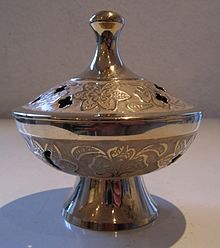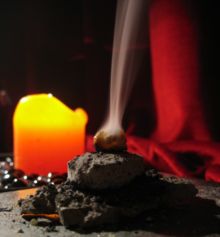Smoking (ceremony)
" Incense " refers to the burning up of incense on hot charcoal, in the incense burner or the lighting of incense sticks or incense cones . As a result, fragrances and / or active substances are released into the ambient air.
Old Egypt
Kyphi referred to a ritual incense in ancient Egypt.
Arabia
In Arab culture is incense , a well-known and popular fragrance. Clothing is still traditionally disinfected today by smoking and getting rid of bad smells, and frankincense extract is used as an eau de toilette (or perfume ) by women and men alike.
China
In China special scented smoke burners were created for smoking .
In Chinese medicine , moxibustion has a warming and at the same time smoking effect.
Japan
In Japanese Kōdō , the glowing charcoal is covered with ash and a metal plate is placed over it, on which the active ingredients and fragrances evaporate without burning . This prevents smoke formation .
Europe
Smoking ceremonies were already used by the indigenous peoples of Europe. Especially by the Celts and later by the Germanic tribes. In the liturgy of the Roman Catholic , Orthodox and Anglican Churches , smoking is done with a censer during special services . Common incense substances are frankincense mixtures with styrax , myrrh resin and other cheaper resins, and occasionally aniseed . This mixture of different smoked products is called "church mixture" and contains little expensive frankincense. The ritual itself is called " incense ".
During the Rauhnächten (also called "Rauchnächte"), farmers in Catholic areas fumigated the stables of cattle with incense. This custom also seems to have its roots in pre-Christian times.
Indians
In the case of the North American Indians, before ceremonies such as the sweat lodge ritual, the rooms in which they take place are smoked and the people taking part are fumigated and thus allegedly cleaned of harmful energies.
India
In India, incense has been used in Hindu ceremonies and rituals (including funerals and weddings) as sacrifices in honor of the gods for thousands of years. Traditional Indian Ayurvedic medicine has also known incense as a treatment method for various health problems for a long time. India is also the country of origin for the world-famous incense sticks , which there are called "Agarbatti" (from agar wood ).
Tibet
In Tibetan medicine , incense is a form of external treatment that is always used subordinately to proper nutrition and proper behavior.
Criticism or possible health risk
Scientific studies also indicate a possible health hazard from smoking. After studying the University of Duisburg-Essen in 2006 could particulate pollution in Catholic churches the then EU - limit (50 micrograms per cubic meter of air) exceed by more than four times. In 2010, the journal Atmospheric Environment stated that burning incense sticks was just as dangerous to health as smoking cigarettes.
literature
- Marlis Bader: Smoking with local herbs: application, effects and rituals in the annual cycle. Goldmann, Munich 2008, ISBN 978-3-442-21811-0 .
- Thomas Kinkele: Incense and Incense Rituals: Powerful rituals with fragrant messages. The manual for the smoking practice. Windpferd Verlag, Oberstdorf 2010, ISBN 978-3-89385-372-4 .
- Wolf-Dieter Storl : Nature rituals. Find your roots with shamanic rituals. AT-Verlag, Aarau 2004, ISBN 3-85502-964-4 .
Web links
see also tobacco products (furs)
Individual evidence
- ↑ Christof, Klaus D./Renate Haass: Weihrauch. The scent of heaven. Dettelbach (Röll): 2006. Pages 89-101.
- ↑ Incense in Northern Europe [1]
- ^ Richard Billinger : Rauhnacht . Drama. 1931.
- ↑ Joseph Bruchac : The Native American Sweat Lodge. History and Legends. Crossing Press, Freedom CA 1993, ISBN 0-89594-637-8 .
- ↑ Incense in the Far East - India. Retrieved April 14, 2016 .
- ↑ Incense sticks. Retrieved April 14, 2016 .
- ↑ "Fine dust alarm through incense" Article in the Hamburger Abendblatt dated August 8, 2006, accessed on January 20, 2016.
- ↑ "Caution: Fine dust in incense" , article in the Kölnische Rundschau from August 7, 2006, accessed on January 20, 2016.
- ↑ "Esoteric fine dust. A new study shows that incense sticks are just as dangerous as cigarettes. Allergy sufferers are particularly at risk. ” Article in the Süddeutsche Zeitung of May 22, 2010, accessed on January 20, 2016.




